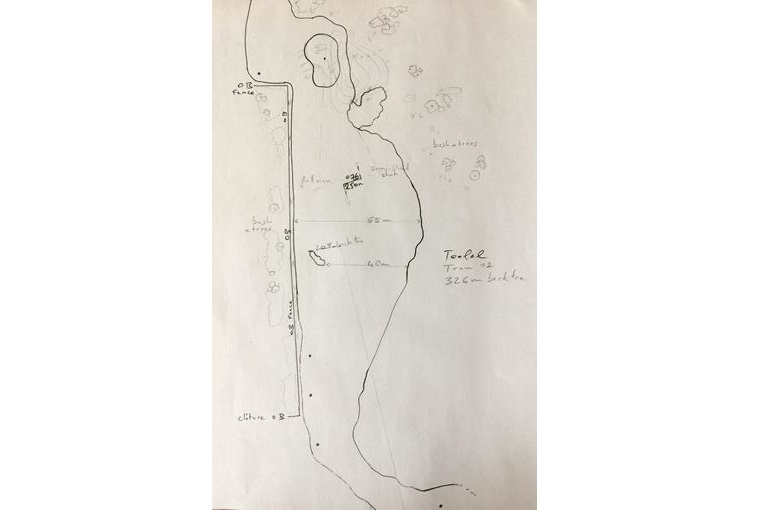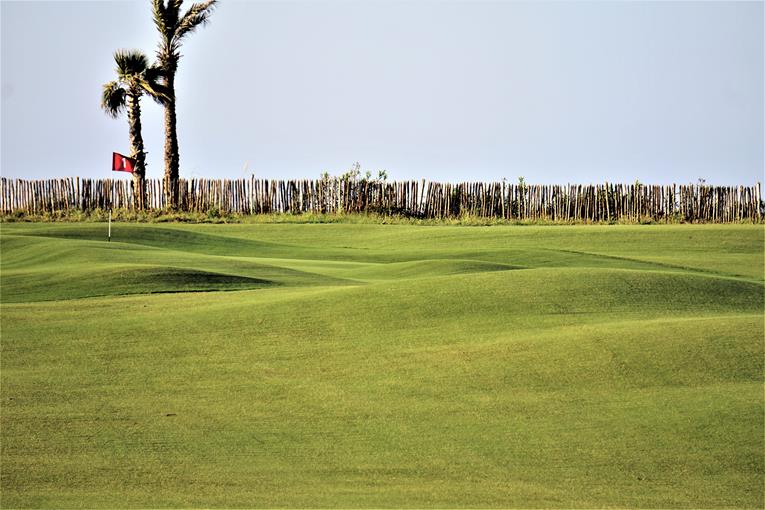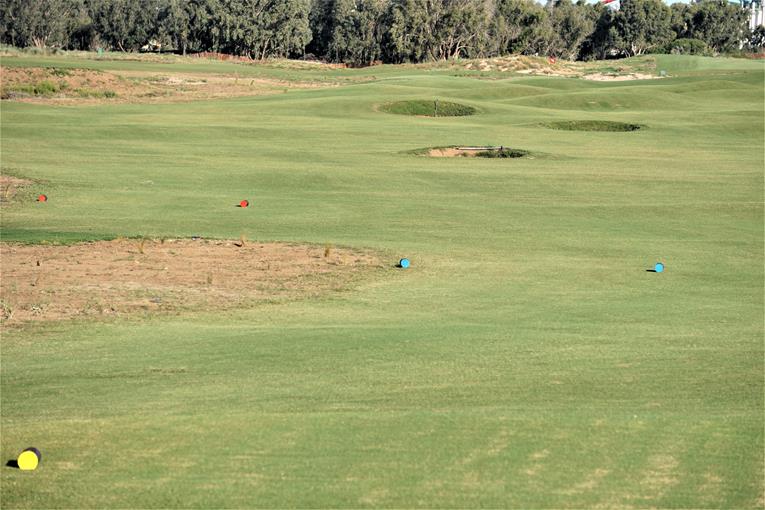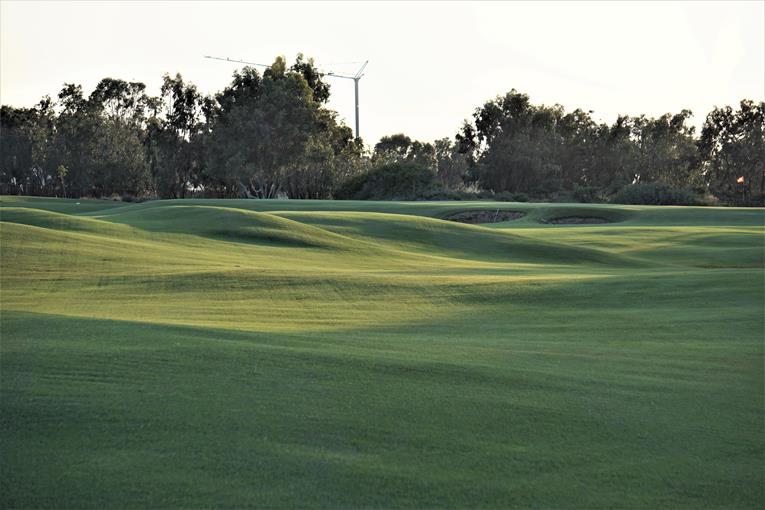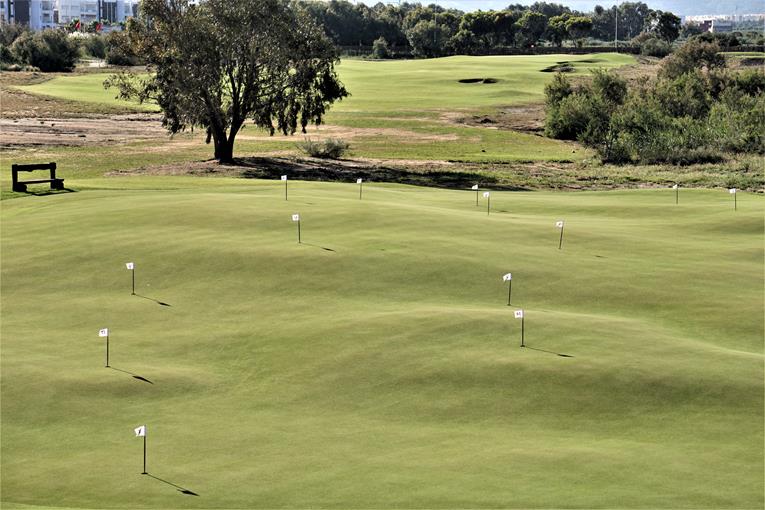Feature Interview with Nicolas Joakimides
June, 2018

French golf professional and architect Nicolas Joakimides on the 2nd tee at the Teelal Course. The course is slated to open later in 2018.
How did you become interested in golf course architecture?
I began playing at 13 years old and simultaneously, started drawing golf hole sketches at school; The interest in golf design was there already!
What has influenced you the most in terms of what you like in architecture? Books?
I was age 16 when I bought my first golf book: The Anatomy of a Golf Course by Tom Doak. I had no idea who he was but I liked the book very much and remember saying to myself ‘Okay, everything about golf design is said. ‘ I have never been curious to read any other golf architecture book since!! Later, I discovered the Golf Course Architecture magazine and GolfClubAtlas website.
I just wanted to discover different courses and have my own ideas, which happened after playing over 400 courses around the world as a professional player.
Have particular courses influenced you?
All the links course that I have had the opportunity to play in Scotland and Ireland: these courses are fun and much more natural than what you typically find inland in Europe.
Any certain people exerted sway?
Tom Doak after Pacific Dunes was created. He once gave an interview regarding the opening of PacDunes and it was the first time I had heard something interesting in an interview about golf design.
What three courses would you most like to see for the first time that might help stimulate design ideas?
Tara Iti, Old MacDonald, and Gamble Sands.
They are all a long way from where you are based in France! Speaking of which, your first course is in the vicinity of Pau, France. Tell us about it.
Navarrenx Golf Club is 1 h by car from Biarritz and Pau. I spent a lot of time on this beautiful site: old trees, creeks and views of the mountains. Nine holes are open to play now and the complete course should be playable in 2019. I really like what I did there … but the owner didn’t follow exactly my plans because he has his own ideas. I couldn’t convince him to let me work. I have learned quite a bit from the experience and a lot goes into the final outcome that might surprise many golfers.
Describe a favorite hole there.
Hole 9 is a short par 4 (280 yards from the backtee) with a slightly elevated green; drivable for long hitters or close to it but the narrow entrance between a tree and a deep green bunker make you think you might better lay up. Two bunkers in the middle of the fairway make you wonder if you would better to lay up short … or perhaps left … or right of that pair of bunkers. This is a difficult choice to make and it might finally make you think again about going for the green after all! Any time you have to think on the tee, I think I have accomplished something. Plus, whatever decision you make today might be different tomorrow!
You definitely like your short two shotters and you produced a pair of sparking ones in Morocco that happen to be the second and third holes. Let’s transition to there: How did you become involved to produce the second course for the Saïdia Resort in eastern Morocco?
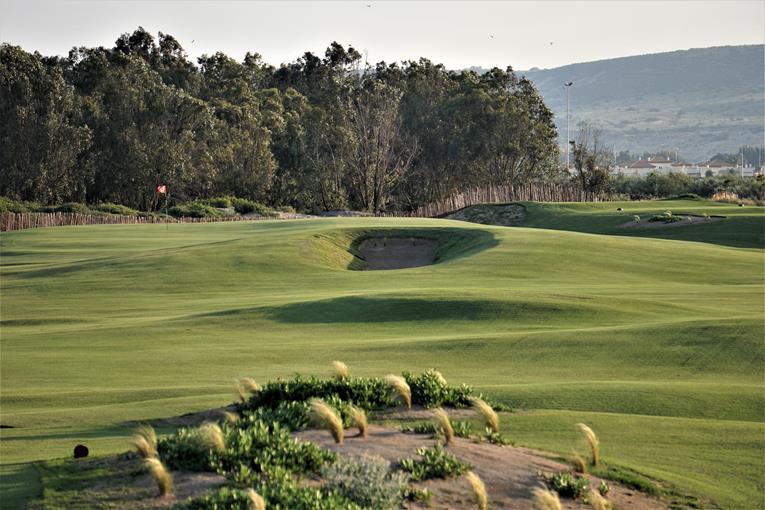
The left hole location teases the golfer to have a go at the 300 yard third hole. Hole locations right of the bunker are more problematic.
I met the Saïdia resort general manager after playing a round during a pro-am on the resort’s first course. He asked me how I liked the course and told me he had two other courses to build! Over time, I convinced him to hire me.
Describe the opportunity.
It was unbelievable, especially once I realized that I had 330 yards along Saïdia beach and that it was all sand. On my first visit, I met sheep on the land – what a good sign! Small undulations existed which were perfect for golf (‘teelal’ is small dunes in Arabic). Five of the holes play near the sea and the rest are inland with four holes going through existing homes. The good news there was that the corridor between homes was 160 yards wide and we have planted 500 trees on the sides. I had a Pinehurst N 2 look in my mind for these holes. No tree is within 20 yards of a fairway. Trees grow fast here, so I am confident that the players will soon only see a large fairway, sand on the side with wire grass, and trees on those four holes and not homes.
The general manager really trusted me and let me do what I wanted. I had no restrictions except the clubhouse position. For example, they were okay to build a 400 yards long stone wall as long as I was within the budget. I just had to explain why I needed it that long on 16 but it gives the course an old world feel right away.
Overall, this course will play as a links but will take you through three different scenery : beach grass until h 6 , broom from 7 to 10, trees from 11 to 14 and broom again to 18. I like this variety and it reminds me of Chiberta and Moliets in France (and makes me think of Cypress point ).
I had enough land so that no two holes in a row go in the same direction and I just feel very lucky to have had this opportunity.
Some golf professionals lend their name to a project but have little overall involvement with the final design. In your case, you actually were on the excavator and did most of the shaping, which turned out really well, at least to me eye. How did you learn to push dirt around?
I learned how to use the excavator in two weeks in Biarritz. Before that, I had spent 80 days looking at shapers working with me in Navarrenx. I realized how crucial the shaper was to the final design and also, how difficult it is to find shapers in Europe that work 100% to what I am trying to accomplish. Therefore, I set about learning how to shape and I kept learning at Saïdia.
I didn’t need much time to build a green or a bunker I had plenty of time to think about it before we began construction. I start with an idea on paper: a sketch. As I begin the actual shaping, things evolve and I make tweaks until I am happy with it and I think that it will produce the best golf. If I don’t feel totally satisfied, I take my time to re-think and finish it until it appeals. That is the benefit of having an architect on site that does his own shaping.
How do you know when to become satisfied with your handiwork an to leave well enough alone?
I have always liked art and design and liked to draw. I have a feeling inside me that signals when the work is finished, meaning the features both look and play right.
Walk us through the process of how you produced the random one and two feet fairway contours.
I explained to the Moroccan dozer driver what I wanted and show him a few sketches. His french was average so sometimes to make me understand I had to draw it in the sand. After his work was finished, I came along with the excavator and re-worked here and there some large undulations and separated them into three smaller ones. I was careful to never repeat myself in this process. It would have been boring otherwise.
I really enjoy creating original movement. And it wasn’t that much work.
How/when did you develop an affinity for punchbowl greens?
I don’t remember exactly but probably by watching my ball bouncing back towards the flag after a good shot in Scotland. Or after realizing on a 20 yards chip I could use the slope past the hole to let it come back .
Punchbowl are saying to me : ‘you don’t kneed to be perfect‘ and things like ‘Play with me … it will be fun.’

The front of the 17th green is a punchbowl while the back half of the green balloons out and drops down to a lower level.
You are big into strategy and playing angles. As an example, please provide us with a sketch of your 12th hole and walk us through its creation.
I did what Coore/Crenshaw did in Arizona: painted a white line in the desert and declared the other side OB. In my case, I installed a pretty wooden fence down the left side which runs from tee to green on this 360 yard hole. I did so appreciating that the natural mound in the front right of the green hide the putting surface from the right but not at all from the left. It works because you are faced with a 75 yard wide fairway.
The fence make you think : Is flirting with the out of bounds worth the risk ?
The green is sharply tilted from right to left so you really need a good golf shot to hold that green from the right. I didn’t want people to lay up down the left side with a iron or hybrid, so I installed a fairway bunker that requires a driver to carry it.
It’s funny to think that the best shot onto that green is a cut iron : the common shot of a right handed, 24 handicap player.
You aren’t a big fan of heavily bunkered greens and the Teelal Course is a testament to that. Why so?
Teelal has no rough, only sand and local plants. I wanted to give the feeling that just a little bit of grass was seeded here and there to give the opportunity to people to play golf on this (links) land close to Saïdia beach. Heavily bunkered greens would have been too much on the landscape and wouldn’t give you that particular feeling.
My second reason is to cultivate fun and playability. Golfers want to score and most are better from short grass than from traps. So they can relax on iron shots and swing freely. Less greenside bunkering means faster play and less time spent raking. Also, the end result was less expensive to build and to maintain as well.
The key though to make the golf still be interesting was to create nice undulations + short grass. I think we succeeded in doing that.
I completely agree and my above photograph confirms as much. Please detail a bunkerless green complex at Teelal that challenges all levels of players.
Of the 5 bunkerless greens we have at Teelal, the first green is no stress for a low running approach. The contours help your ball stay on the green if you are long or a touch too much to the left.
Except for a left pin position, a mound is right in front of you and will deflect any shot that lands in front of this small green. And that’s what the good players only have in mind.
There is a lot of mediocre golf on continental Europe. What are some underrated features that you wish you saw more of in new designs in Europe?
Mediocre golf is king in Europe. Our best course are designed mostly by English designers or Americans (if you like championship courses). I dream about variety and a sense of esthetics. Is it possible to have something else other than an oval green with oval, flat bunkers on the sides?! How many punchbowl greens do we have? Shallow ones, front to back slopes, angled greens? Wild greens?
I wish I could meet more tiny bunkers into the line of play as well.
It would be great for golf to see courses finally be set up correctly for women too. A set of tees in the 4400 yard range would be ideal for many ladies.
What are some overrated features that you wish developers/architects would move away from?
I am really tired of narrow, wooden course as they stifle thinking and creativity. Woods are beautiful; I love to walk in forest and I love Pinehurst Number 2 but our European wooden course are so narrow, it’ s killing strategy and fun. It doesn’t help either to swing freely or to allow different trajectories. Other features to move away from: water, bunkers and thick rough.
You are an ace player. What are your three favorite courses on continental Europe on which to play a tournament?
I haven’t played all the best European courses to answer precisely your question but to date I would say: A stroke play tournament at Chantilly Old Course, a match play tournament at Les Bordes and a 7 club tournament at St Emilion Golf Club.
That is some answer – I like it! You like greens that fall from front to back and that is certainly one way to befuddle the long bomber. What are other ways to challenge the guy who drives it 300+ yards? Or does challenging .001% of players even matter to you?
There are many ways to challenge the long hitters. I design courses for all the players so yes, it does matter. Distance should be an advantage sometimes but precision (in distance and direction) should be even more rewarded.
What is a challenge for long hitters ? First, let’s see what how they play the game…
They hit it high, with too much spin, they can miss by a lot their target, they have a weak short game and probably average putting too, they don’t know how to play the wedges, they want to impress other players. So it means if you want to win a match play to someone who is a long hitter, you should choose a course with the following characteristics:
Windy region, cold climate, par 68, play the ball as it lies, short par 4’s and 3’s, reachable par 5 well protected on one side, undulating greens, small greens, severe back to front greens, or front to back, punchbowl green, greens surrounded with short grass, well protected greens on one side and at the back, strategic holes in general, bunkers at in 310-340 yard range from the back tee (wind in the back), angled fairways and greens. Undulating fairways at 280-350 yards from back tee also serve to keep the better player off balance.
Finally, with the right amount of uphill short grass slope in front of the green, the short hitter can use it to slow down his low approach while the long ball hitter has to worry about controlling the spin and not bringing his ball back down off the green.
Tell us about Atlas, the practice putting green on the east side of the clubhouse. What was the inspiration behind it?
I first discovered the Ladies Putting Course called Himalaya in St Andrews in a golf book. A few years later, I went there to play in a pro-am. We were lodged at that very nice hotel on hole 17, so we were close to Himalaya Putting Course. Every evening I crossed 17th fairway with my putter and two balls and played two rounds.
I thought it would be great in Saïdia to have this kind of green, for beginners and all golfers. It’s great fun, requiring both touch and imagination and is well undulating but not as immense as Thistle Du at the Pinehurst Resort or the Punchbowl in Bandon for economical reasons.
We named it Atlas after the name of the highest mountain in Morocco. It was also the green I had the most fun to shape!!
I hear mixed reports on the host course for the Ryder Cup this year, ranging from ‘totally manufactured’ to ‘should produce exciting moments under the Ryder Cup format.’ What are your thoughts?
I know very well this place from the opening day and it has gotten worse with time. When the French Open became a big tournament, they started to destroy the course: eliminating bunkers, reducing fairway width from 45 yards to 30 yards, thick rough close to fairway, new back tees making it long to play and to walk. They removed bushes like gorse that were good for hiding things and gave a wild look. Like many modern courses, my feeling is that this course has no soul. In this case it was just lost over the years.
Surrounded by as many people as possible, it can still produce excitement on 16th and 18th but that’s not really what I am looking for. Neither is the game, neither is golf design.
Good point! What three courses would you like to see restored in Europe?
Lys Chantilly, designed by Simpson, it has way too many trees. It could be as good as Chantilly, Vineuil.
Granville is the only real links course in France but could be much better.
Navarrenx : My 18 hole course in Navarrenx already need changes !! The owner didn’t finished it exactly as it was planned. With a little bit of investment, I could turn this place in a top 3 in France as the site is so beautiful.
France is hugely underrated as a golf country. Assuming access isn’t an issue, what six courses would you recommend the traveler see over a ~one week period?
Fly to Paris, rent a car and go to ( from north to south ) :
1) Chantilly (Simpson)
move to Orléans region to play
2) Les Bordes (Von hagge)
move to Bordeaux region to play
3) Médoc, Les Châteaux ( Coore )
4) Médoc, Les Vignes ( Whitman)
5) St Emilion (Doak), and end up close to Biarritz at
6) Navarrenx Golf Club (moi!)
Why should someone hire you?
The 1st reason is that I have demonstrated that I can build something both different and fun at Teelal. Time will show it will be a great golf experience, one in which you want to play many rounds. I already have SO MANY NEW IDEAS for my next course that I have NEVER SEEN anywhere on the planet. A fraction of it can be seen at Teelal. But it’s only a fraction. To make it happen, I would need a good site but not necessarily a great one, a good budget but not necessarily a big one. I will need the contribution of good shapers and I would shape myself with the excavator.
You should hire me …. if you are looking for a unique golf course that is a ton of fun EVEN THOUGH it will be wildly different from the modern golf courses that appear on TV.
The 2nd reason why you should hire me is if you share with me that the spiritual world and the material world are one. A golf course should favor spiritual experience, meaning you can experience joy, peace, and a quieter mind. It doesn’t happen as often as it should because the courses we have on this planet are not particularly designed for it. Playing golf can be very good for your health. It can help you in your life if your soul can be touched.
I would like to create a golf course with that purpose. Old trees would help and a wellness center on site would be good. I would provide a different way to learn golf and improve your game. Championship courses and trackman are killing the game and the person – Let’s go the other way!




